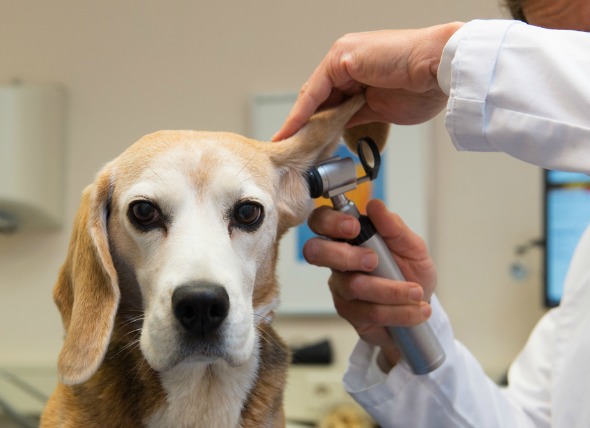

Hypertrophic osteodystrophy is a disease of the front limbs in large-breed puppies. Affected puppies suffer from a noninfectious inflammation of the bony spicules (pointed, mineral structures) in the metaphysis of the long bones. The metaphysis is the conical part of the bone between the epiphysis (the growing end of the bone), and the diaphyses (the shaft of the long bone). The most severely affected bones are those that grow most rapidly. Swelling around the metaphyses, and bone deposition, cause widening of the metaphyses. Tiny fractures of the bony spicules in the metaphyses, and metaphyseal separation occur close to and parallel to the physis. The physis is the epiphysial cartilage in the joints – the soft, connective part of the bone that hardens (ossifies) after full growth has been reached, joining the parts of the bone into one. There may also be ossifying periostitis, a painful inflammation of the most external layer of the bone, the periosteum. Ossifying periostitis can cause bits of the periosteum to break off and mineralize in the soft tissues of the leg, and soft tissue in other organs may mineralize as well.
Affected puppies may also have accompanying signs of pneumonia and diarrhea. While the cause of this disease is unknown, it is currently suspected to be a hyper-reactive response to vaccination.
Suspected (but not proven) to be a reaction in the bone-producing centers to vaccination.
Your veterinarian will perform a thorough physical exam of your pet. While a chemical blood profile, a complete blood count, and a urinalysis are good indicators of possible systemic disease, radiograph imaging of the legs is crucial for diagnosis of hypertrophic osteodystrophy. Thoracic (chest) radiographs will also be taken if pneumonia is suspected.
There is no cure for this disease, but most puppies will recover on their own after one or two episodes. This disease can last from days to weeks, and puppies may be left with permanently bowed legs.
Puppies that will not, or cannot stand or move should be hospitalized with bed rest, and turned frequently by the nursing staff. If the puppy is dehydrated, fluid therapy will also be administered. A feeding tube can be inserted if your puppy is unable to eat. Your veterinarian will probably prescribe anti-inflammatory medicine to treat your puppy’s pain symptoms.
You should only walk your puppy on a leash during episodes. All other physical activity, such as freely running and jumping, should be restricted. The puppy should be given a small, confined, well-padded area where it can rest when it is not being walked. Puppies can be fed their normal diet, but supplements, especially Vitamin C supplements, should be avoided. If your puppy shows any signs of systemic disease, such as bloody diarrhea, spitting up blood, pneumonia, weight loss, or any other change in its condition, you should call your veterinarian immediately for advisement.
 Cancer of the Blood Vessel Cells in Dogs
Hemangiopericytoma in Dogs
A hemangiopericytoma i
Cancer of the Blood Vessel Cells in Dogs
Hemangiopericytoma in Dogs
A hemangiopericytoma i
 Toad Venom Toxicosis in Dogs
Toad Poisoning in Dogs
Toad venom toxicity is rel
Toad Venom Toxicosis in Dogs
Toad Poisoning in Dogs
Toad venom toxicity is rel
 Inflammation of the Soft Tissues in the Mouth in Dogs
Stomatitis in Dogs
Stomatitis is the condition wh
Inflammation of the Soft Tissues in the Mouth in Dogs
Stomatitis in Dogs
Stomatitis is the condition wh
 Arthritis of Multiple Joints in Dogs
Nonerosive, Immune-Mediated Polyarthritis in Dogs
Arthritis of Multiple Joints in Dogs
Nonerosive, Immune-Mediated Polyarthritis in Dogs
 Ear Hematoma in Dogs
Canine Aural Hematoma
Ear hematomas, also known a
Ear Hematoma in Dogs
Canine Aural Hematoma
Ear hematomas, also known a
Copyright © 2005-2016 Pet Information All Rights Reserved
Contact us: www162date@outlook.com